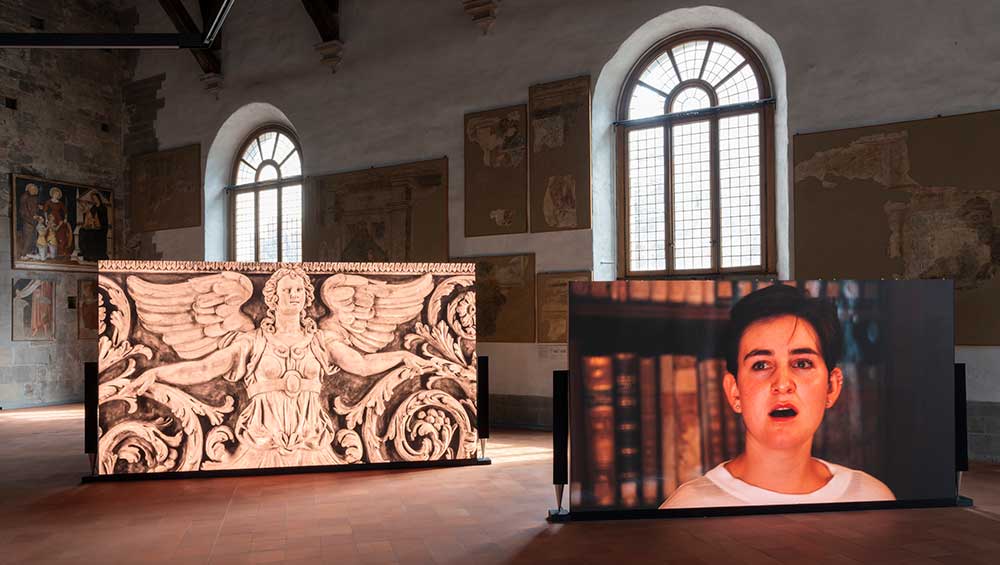
Sonia Boyce. Benevolence, 2024. Installation view, GAMeC / Palazzo della Ragione, Bergamo, 2024. Photo: Lorenzo Palmieri. Courtesy GAMeC - Galleria d'Arte Moderna e Contemporanea di Bergamo. © Sonia Boyce by SIAE 2024.
Galleria d’Arte Moderna e Contemporanea
Bergamo, Italy
by VERONICA SIMPSON
The polystyrene is a master stroke: if Lin May Saeed (1973-2023) had conjured her creatures out of anything more solid – heaven forbid, marble or bronze – they might have seemed too menacing, ossified or reified. Instead, these real/fictional creatures of her imagination prowl towards us, light as air. Not in any way threatening; just mobile, alert, seemingly alive while clearly not. Utterly recognisable – a hyena, a calf struggling to stand, an anteater, an ocelot, a kind of oversized prehistoric cat that could easily have stepped from the decorative surface of an Egyptian urn – ancient and modern animals overlap in Saeed’s mythologies. To the left of the entrance, in one of several polystyrene reliefs, a deer stands against a cornfield, ears pricked, muzzle pointing towards us as if scenting our proximity, in a timeless scene brought bang up to date by the detritus that seems to be filling the stream that flows by its legs.

Lin May Saeed. Installation view, GAMeC, Bergamo, 2024. Photo: Antonio Maniscalco. Courtesy GAMeC - Galleria d'Arte Moderna e Contemporanea di Bergamo.
Though the polystyrene is in no way disguised, Saeed’s skilled carving and painting of these frescoes and sculpted creatures is cleverly done to amplify the desired texture, whether fur or claws, scales or rock. And to the right of the door is a relief that epitomises everything the artist – and the curator, Lorenzo Giusti – wished to set in motion with this exhibition: dialogue between animals and humans. Four-legged and two-legged beings sit around a table, appearing to converse (though they are doing more than that, according to the title, Séance with Humans and Animals, 2007). “She dedicated her life to animals and exploring human and non-human relationships,” says Giusti, director of the Galleria d’Arte Moderna e Contemporanea (GAMeC), where we are viewing Saeed’s work. She of all artists was the key to Thinking Like A Mountain,* a two-year programme of art curated by Giusti in and around Bergamo, as well as the provocation that sparked his theme for the Biennale Gherdëina 2024, high in the Dolomites, titled Parliament of Marmots, for which he is also the curator (see Beth Williamson’s review). Giusti had planned to commission more of these animals from Saeed, carved in wood, but sadly she died in 2023, so he has instead curated a two-part retrospective in tribute to her, across both territories.

Lin May Saeed. Landscape with ant hills, 2021. Styrofoam, acrylic paint, steel, wood, 139 x 210 x 30 cm. Photo: Wolfgang Günzel. Courtesy: Lin May Saeed Estate, Jacky Strenz, Frankfurt/Main.
Part of the 1970s activist movement inspired by anti-species-ist philosophical discourse, Saeed was based in Berlin, with German-Jewish heritage on her mother’s side and an Iraqi father, and she drew on the mythologies of both lineages and geographies to create her creatures and narratives. Whether dipping into the Mesopotamian epic of Gilgamesh or Christian and Islamic stories, her work prioritises a spirit not of conflict between these species, but of empathy, says Giusti, declaring in his introductory text: “Her work was always aimed at instilling in people a new sensitivity and awareness that would allow them to establish a peaceful and respectful relationship with other living creatures, thus creating a sort of new iconography of interspecies solidarity.”
It may seem ironic that Saeed’s material of choice, polystyrene is a byproduct of the petroleum industry, though she often salvaged scraps from construction sites. However, it resonates on other levels: flagging up the folly of humans’ extractive approach to the planet, as well as the benefits of its lightness and malleability, the material offered Saeed great advantages for scaling up production as well as ease of transport. The posse of animals parading towards the gallery entrance are all part of a series she began in 2008, The Liberation of Animals from Their Cages III, and the timber frames on which the sculptures stand double up as plinths as well as cages for transporting them. “Truly they have been liberated from their cages,” says Giusti, as we tour the exhibition. He has also – intentionally – placed them marching towards the exit.
Moving between the rooms and then around the other spaces of GAMeC – a late-20th-century gallery adapted from a former convent – one is aware that the rooms are more modest and cellular than is now the fashion, however skilfully filled with GAMeC’s eclectic but engaging collection. And part of Giusti’s inspiration for Thinking Like A Mountain is to prepare the community and wider audience for a relocation to a dedicated contemporary art space now being built inside a partly demolished 1960s sports arena (the region gets top marks for retrofitting and repurposing its built assets, though Giusti and his team have had to work hard to ensure the new gallery will provide all the scale and flexibility a 21st-century art space needs). In conversation, Giusti is passionate in his intention that Thinking Like a Mountain should knit together GAMeC’s existing audiences (visitors from Venice and Milan as well as local art lovers) and the wider community, who are typically less engaged. So as the two-year programme, which includes 20 artists or studios, evolves (concluding as the new space opens), we may well see an arrangement of works much like this early stage: balancing exhibitions in GAMeC with those in the city and in the surrounding countryside.
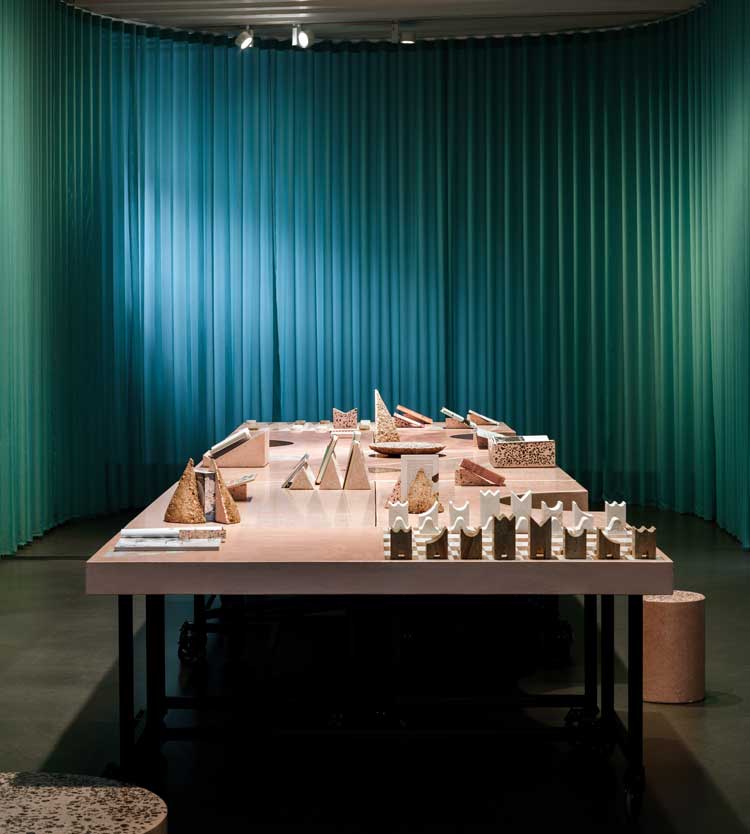
Studio Ossidiana. Massi Erratici, 2024. Installation view - GAMeC, Bergamo, 2024. Courtesy GAMeC – Galleria d’Arte Moderna e Contemporanea di Bergamo. Photo: Riccardo De Vecchi.
For the opening salvo, there are two exhibitions at GAMeC, sort of. Giusti invited Studio Ossidiana, an Italian design practice now based in Rotterdam, to create a set of furniture in sympathy with the theme of this programme, to use in his shop here. But the brief was that the furniture could then travel to the new gallery. Working together with local studio Frantoio Sociale, what they have delivered, titled Massi Erratici, is so much more than just furniture: large and small modular pieces, fashioned out of the mineral waste from local mining and concrete manufacture, their polished, pink-hued planes have a timeless elegance, a simple yet deeply pleasing and practical deployment of the same geometries at different scales, including triangular book stands and outsized chess and backgammon pieces that are placed (ready for a game) on the outsized boards that edge the display desks.
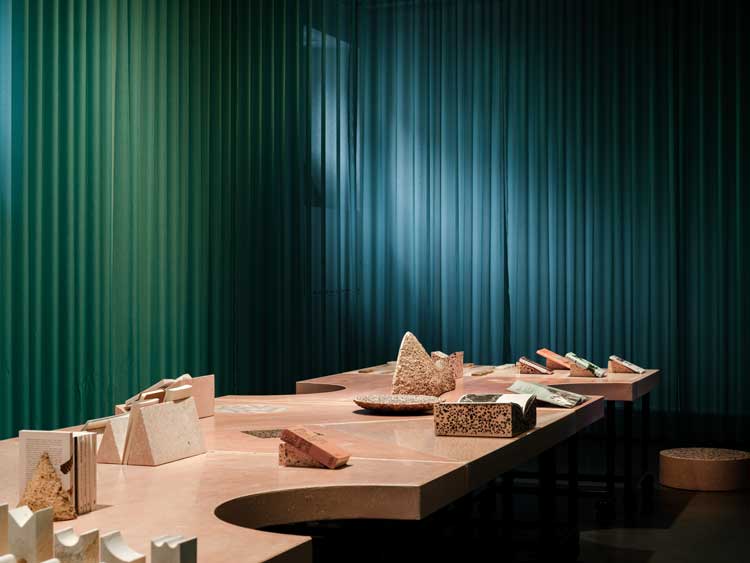
Studio Ossidiana. Massi Erratici, 2024. Installation view - GAMeC, Bergamo, 2024. Courtesy GAMeC – Galleria d’Arte Moderna e Contemporanea di Bergamo. Photo: Riccardo De Vecchi.
To visit Bergamo is to see a handsome Italian city of two parts: the medieval Città Alta that perches high on the hill, against a poetic, mountainous backdrop, and below that the sprawling but substantial and civic, 20th-century modern metropolis. GAMeC sits at the edge of the Città Alta, along the last of the winding cobbled streets. But anyone who travels by rail or road through the region around Bergamo or Milan, or between Bergamo and Venice, cannot fail to be aware of the huge amount of industry that brought prosperity and employment to this region throughout the 20th century, but had a brutal impact on the local landscape. While plenty of industry remains, much has gone the way of all European manufacturing (either offloaded to China or acquired and consolidated as part of a global conglomerate). It was important to Giusti that his Thinking Like a Mountain programme activates areas of dwindling or diminished industry – villages sometimes built to service the factories and their workers.
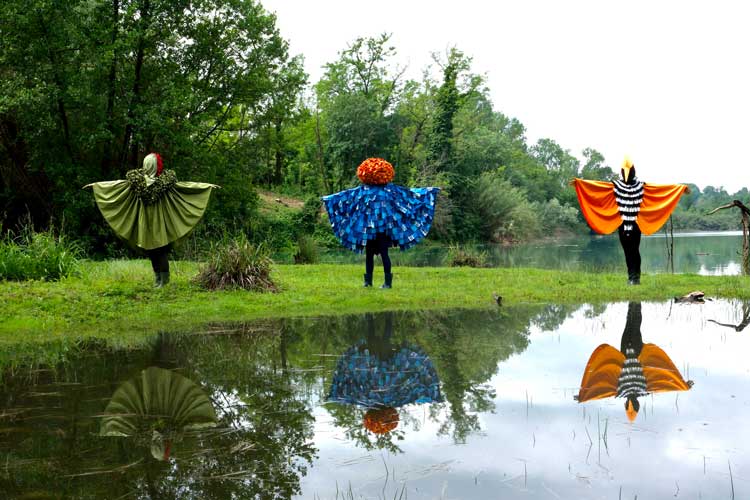
Performance by Mercedes Azpilicueta, Que Este Mundo Permanezca (May This World Remain), Oasi della Biodiversità, Brembate. Photo: Paolo Biava.
At the opening weekend of Thinking Like a Mountain, there was, by all accounts, a thrilling performance by the Amsterdam-based Argentinean artist Mercedes Azpilicueta, Que Este Mundo Permanezca (May This World Remain). It took place at the Oasi della Biodiversità, Brembate, at the heart of an environmental regeneration project, which is overseen by the Nuova Demi company following the end of gravel- and sand-quarrying here. The company now carries out conservation activities, including monitoring water quality and bird and insect populations. As a result, the Adda river, once filled with industrial effluent, is host again to an encouraging variety of plant and animal species. Azpilicueta’s performance drew on the idea of three returning birds (the kingfisher, the green woodpecker and the hoopoe) and scripted, then collaboratively interpreted their imagined interactions through the work of three professional dancers and teachers at the Bergamo Art Academy, Antonella Fittipaldi, Nicola Forlani and Aurora Rota. The trio were clad in costumes echoing the plumage of the birds (created by designer Alberto Allegretti) and the performance was structured in several stages, tracing a path around the central water feature at the heart of the Oasis, with this normally closed area opened to the public. The performance’s intention was to highlight adaptation, resilience and the potential for transformation.

Chiara Gambirasio. V’arco, 2024. Iron, enamel, metal pigments. Photo: Nicola Gnesi. Courtesy GAMeC - Galleria d'Arte Moderna e Contemporanea di Bergamo.
In another part of this striking, mountainous landscape, Bergamo native Chiara Gambirasio (b1996) developed a participatory project that has found lasting expression in two new sculptural forms, set in Castione della Presolana, an area where the steel manufacturing company Dalmine used to have a summer camp, a 40-minute drive from Bergamo. For 30 or more years, generations of workers’ children were invited to spend part of their summer vacations in a dedicated cluster of holiday apartments (now long abandoned) set in the historic village of Rusio, with its own remarkable little chapel. Gambirasio tracked down some of the women who had attended the camp as children to join her in workshops; through creative exploration and storytelling, and a trip to the camp, they reactivated their memories. What emerged was a complex emotional narrative majoring on loss – both the women’s memories of anxiety at being separated from their parents, and also a sense of loss of the close connection with nature that was one of the best memories from summer camp.
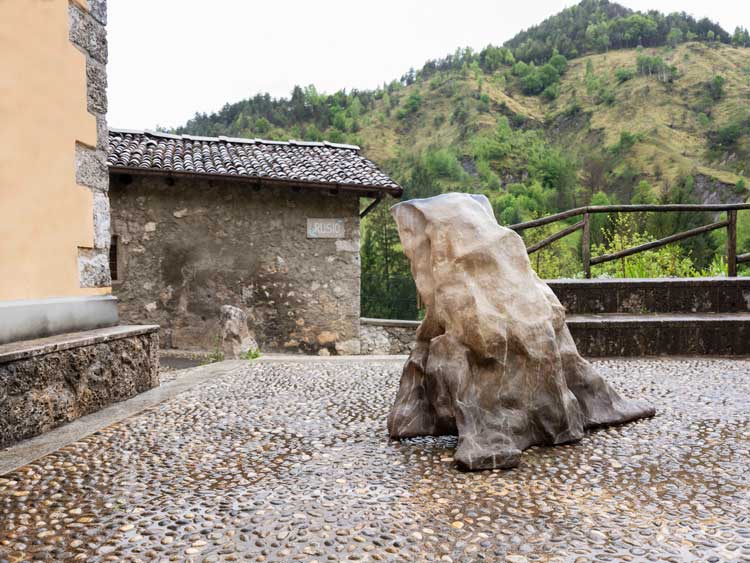
Chiara Gambirasio. M’ama, 2024. Cement mortar and glue, oxide pigments, fluorescent pigments. Photo: Nicola Gnesi. Courtesy GAMeC - Galleria d'Arte Moderna e Contemporanea di Bergamo.
This emotion informs a new sculpture that now sits beside Rusio’s chapel. Evoking something between a tree stump and the surrounding mountain forms, it is called M’ama to evoke Mother Nature or Mother Mountain. It can be accessed by car, but Giusti hopes most visitors will take a meandering and sensory route through the woods and along the river, about 20 minutes from a road bridge where the other sculpture – a rainbow-hued archway – is placed. Called V’Arco, it evokes the three bridges that trace the river’s descent towards the valley. Between the arches are branch-like struts, and it is painted the colours of an “earth rainbow”. When sun bursts through the mountain mists, the branches cast shadows across the valley floor, while the arc should – on a clear day, and depending on where you stand – frame the imposing peak of Presolana mountain.
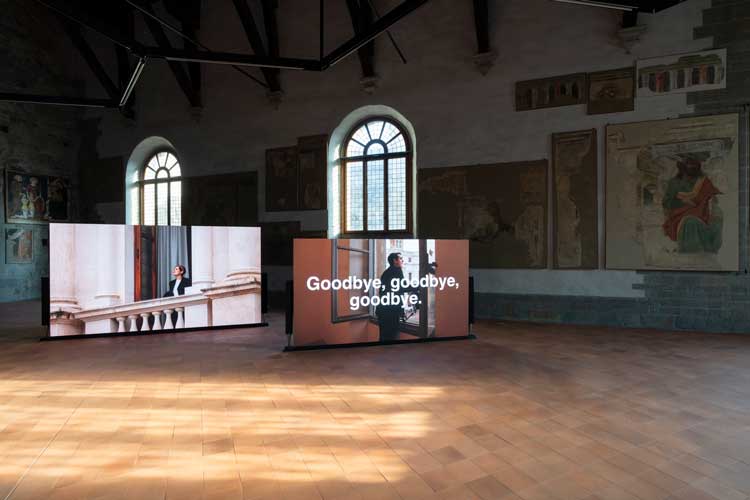
Sonia Boyce. Benevolence, 2024. Installation view, GAMeC / Palazzo della Ragione, Bergamo, 2024. Photo: Lorenzo Palmieri. Courtesy GAMeC - Galleria d'Arte Moderna e Contemporanea di Bergamo. © Sonia Boyce by SIAE 2024.
Sonia Boyce (b1962, London) was commissioned to create a piece for the stunning, frescoed interiors of the Sala delle Capriate in the Palazzo della Ragione in the heart of the old town, in the Città Alta. She brought her customary interest in acoustic memory, the voice, identity and collective creativity to conjure the six-screen installation, titled Benevolence. After researching Italian and regional folksongs, she came across the song Bella Ciao, a mountain song that has become a protest anthem of global and multigenerational significance. Having workshopped with singers from the Gaetano Donizetti Higher Institute of Musical Studies in Bergamo, the selected performers were invited to improvise and use folksongs in public in the Piazza Vecchia, the square adjacent to the Palazzo. The singers were placed in doorways and on balconies, in front of the usual (and totally unprepared) crowds of tourists and visitors. After a period of bird-like, call and response patterns, the performers introduced phrases from Bella Ciao, which were taken up, effortlessly, by the crowd. Segments of these spontaneous singalongs have made their way on to six screens showing the performances at the Palazzo, along with some conducted but also improvised performances set in a local library set within a deconsecrated historic church. It is one of the most moving and coherent pieces of Boyce’s filmed work that I have witnessed, and I was told it has been hugely, positively affecting for local people who have grown up singing these songs.
There are more intriguing works promised in the next iteration, which will be unveiled in October, says Giusti, including films made with and conceived by local creatives and performers, and developed with schools and communities, which will be screened in a delightful, antique village theatre.
Giusti is understandably excited to see what shifts in understanding and connection with the wider community the art programme can achieve through these actions outside the gallery – although the museum has already built up considerable goodwill following its response to the Covid pandemic, which hit this region first, and hardest. Radio GAMeC was launched, reaching out to the community, broadcasting concerts from the museum’s gardens, raising funds and building relationships with those on the frontline of the pandemic. This dialogue with the city has continued with an online magazine, as well as a podcast. The Thinking Like a Mountain project seems like a natural evolution of this inspired outreach, preparing the community for the relocation. It is also an opportunity, says Giusti, for the cultural institution itself to “start thinking of ourselves, and working, differently. We want to change the perspective and do something new, something experimental, questioning the role of a cultural institution. What does it mean to be the museum of the city? Of course, we think globally but our action has to be local. How can we do it and support the community without repeating the same old gestures?” As museums worldwide question their purpose and relevance, in a landscape of shrinking funding and digitally saturated audiences, we should observe Giusti’s programme and its impacts with great interest.
* ‘Thinking like a mountain’ was a term coined by the US ecologist and environmentalist Aldo Leopold, in his 1949 book A Sand County Almanac, based on his observations during time spent in rural Wisconsin. Its usage here is to encourage a perspective that looks at our relationship with nature and our actions on it from a certain distance, temporal and geographical.